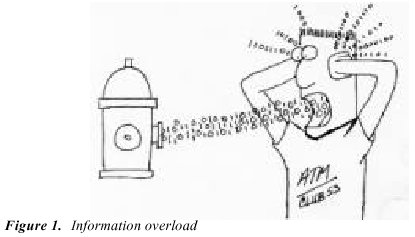
Distance Learning:
|
R. D. Mcleod, M. G. Britton, A. Tregobov, K. Sundstrom
VOL. 12, No. 1/2, 243-256
This paper describes several ongoing distance education activities in the Department of Electrical and Computer Engineering at the University of Manitoba. Differences from alternative and more traditional distance education are being realized through extensive use of the Internet, related tools and applications, and access to experimental broadband services networks.
Cet article rend compte de plusieurs activités en éducation à distance actuellement en cours au sein du département d'ingénierie électrique et informatique de l'Université du Manitoba. On observe des différences entre des modes alternatifs et traditionnels d'éducation à distance en vertu d'une utilisation approfondie de l'Internet, d'outils et d'applications périphériques de même que d'un accès à des services expérimentaux de réseaux à large bande.
Engineering is a discipline that is well suited to benefit from advances in teaching methodologies relating to distance education. Distance education has the potential to significantly improve the way we teach engineering. Several advantages are associated with reduced duplication and greater access to highly specialized courses for students here and elsewhere. This paper addresses specific Internet-related opportunities that we can exploit to distinguish ourselves from more traditional distance education delivery systems. It is based on experiences in Engineering at the University of Manitoba, but many of the basic issues will be similar for others considering or undertaking distance education initiatives. The principal advantages of distance education in Engineering at the University of Manitoba include the following.
Among these specialized sub-disciplines are electromagnetics, micro-elecronics, power engineering, and structures. In addition to requiring expertise in theory, these areas have a strong physical laboratory component. It provides a unique opportunity because there is an existing infrastructure to build upon. The value added component of a distance education course with a remote or virtual laboratory is fundamental to a successful distance education program in highly specialized areas such as engineering. Universities have different sub-discipline expertise, and within a sub-discipline, there are specialities that can be exploited. For example, within the microelectronics community in Canada, there are schools with expertise in high frequency design, analog design, synthesis, system design, and so forth.
The Faculty of Engineering was the first on the University of Manitoba campus to deploy a high speed LAN based on the emerging ATM standards to support broadband services. In addition, a video conference room is being developed that will facilitate the delivery of the formal lecture component of distance education courses. The faculty here are committed to improving the way we deliver courses by using the most appropriate technologies available. This commitment is evidenced by the relatively large number of courses we augment with materials available in electronic format and the large number of teaching awards received by many of the faculty in Engineering.
The major difficulties in developing distance education courses combine technical and psychological problems. We envision distance education as having three major components organized in a delivery hierarchy. For any given course, the appropriate combination of the three modes of communication will minimize the cost and maximize the effectiveness of the learning process.These major components are the formal lecture, the virtual laboratory, and the Hallway Effect.
One obvious method is the formal, televised lecture in which the instructor delivers a conventional lecture to a group of students in a multimedia classroom and simultaneously to groups of students in remote, television-equipped classrooms. Formal lectures incorporate some aspects of a television production. That is, they include “talking head” didactic segments, interspersed with video clips, still photos, diagrams, computer “white boards,” and so on. However, there is also two-way audio, video, and data communication between the originating site and the remote sites so all students have real-time access to the instructor and vice versa.
Although the formal lecture is an important element in distance education, it has limitations. It is expensive, both in terms of the TV studios-classrooms required and the large bandwidth required for audio, video, and data communication among sites. Furthermore, the TV lecture does not lend itself to the type of interaction that occurs between an instructor and subgroups of the class, in a laboratory, or tutorial setting. It does not provide the laboratory component, nor does it allow for detailed interaction between individual students and the instructor, the type of interaction that might occur in the instructor’s office, or in a chance meeting in the hallway-the Hallway Effect. Thus, alternative distance communication media must be used to supplement the expensive televised lecture.
In many engineering courses, hands-on laboratories are still required, but in others considerable design and analysis is done with CAx tools (Computer-aided Design/Analysis/Manufacturing/etc.) With them, an instructor can set up workshop sessions so that students can access specialized CAx tools remotely. These sessions will eventually evolve so that they are online with assistance from TAs and professors. The facilities are a workstation/ laboratory environment supported by a reasonable communications network and software. There is a major opportunity here to design team-based projects that require the students to participate in a design project over geographically remote distances. A main advantage and attraction of this type of laboratory is that the receiving institution does not need to invest heavily in the staff and equipment required to maintain the CAx environment.
The virtual hallway is perhaps the most important aspect of an effective distance education course. We use Hall Effect as a general term to encapsulate all interaction between students and faculty that does not fall into either the formal lecture or the laboratory component. Of equal importance are the Hall Effect facilities and mechanisms to encapsulate interaction between students. The Hall Effect captures the pre-lecture setting up and distribution of lecture and laboratory materials as well as post-lecture materials. The main vehicle for this aspect of the course is the Internet/web and related communication tools and platforms. User groups set up for each course allow students to post course-specific questions or comments and archive responses. Low quality video, audio, and talk sessions will be used for the virtual student lounge. They can be scheduled at a predetermined time for a specific discussion of the lectures or lab materials.
Alternatively, the virtual lounges can be online 24 hours a day, allowing students to visit the lounge at any time from his or her workstation and discuss course materials. The primary mode of interaction for the Hall Effect is asynchronous communication. In each case, there is some degree of overlap and refinement. For example, during a lecture the materials may be recorded and played back off-line, or selective segments may be clipped and added to a video repository augmenting the web course materials.
Our work at the University of Manitoba also addresses the use of technology in distance learning applications that require broadband services and interactivity with remote experts. At present, there is considerable interest in developing courseware for distance education that uses broadcast of lectures and/or self-paced courseware delivered over the World Wide Web (web). At the University of Manitoba, we have also developed a number of such courses (several can be found at our ECE Homepage). Their advantages lie chiefly in the wealth of information that can be made available through hypertext links to other sites.
The majority of existing initiatives do not address distance education in the context of required broadband services and interactivity. Our projects address applications and developing a framework where these elements are necessary. The complexity of these specialized courses and applications, including the inherent difficulty of the course material, requires feedback and assistance from a remote expert.
One of our projects in distance education is The Learning Technologies Centre, which is being constructed as part of a major renovation of the Engineering complex at the University of Manitoba. It will incorporate electronic multimedia distance education classrooms, clusters of networked multimedia work stations, and classrooms equipped with networked computers and video projection equipment to support computer interaction among the instructor and the students. An essential element of the Centre, the Donald Craik Engineering Library, will serve as a resource centre providing multimedia-workstation and CD-ROM access to electronic educational materials from sources throughout the world.
The objectives of the Learning Technologies Centre are:
In order to accelerate the development of the Centre, the Faculty of Engineering has initiated the following pilot projects.
The faculty is currently upgrading a classroom in the Engineering Building, originally constructed to 1950 standards, and converting it into a multimedia distance education classroom. The first phase of the conversion, completed in the spring of 1996, involved the installation of new electrical and mechanical systems, lighting control, architectural finishing, and furniture. The second phase involves the installation of television cameras and monitors, computer and projection equipment, and controls for the lighting and equipment. The room will be connected to the ATM Local Area Network in the Department of Computer and Electrical Engineering, which, in turn, is connected to the ATM (FASTNet) testbed at TRLabs and thence through a 20 Gigabit/second ATM switch to the national network.
At the present time, these ATM networks will likely be used for the synchronous aspects of a course, that is, when students and faculty assemble at predetermined times in specially equipped rooms such as the one mentioned above. However, we envision the day when high bandwidth is directly available to the desktop.
Although the goal is somewhat futuristic, students will eventually have a high bandwidth pipe right to their desktop. It will likely be at OC-3 rates of 155 Mbits per second or provided by Gigabit ethernets! The analogy of drinking from a fire hydrant is most appropriate. This represents a tremendous opportunity for us to develop courses that will best take advantage of this rapidly evolving technology.

The types of equipment required will be similar to that used for connecting PCs to a hub type LAN. For example, a prototype ATM LAN found in laboratories could resemble something like that of Figure 2. A basic multimedia LAN would include a local ATM switch or fast Ethernet that can be configured to route packets between the local machines or to the network edge equipment. Network edge equipment is the equipment that you would connect to establish connectivity with the outside world. The multimedia machines can include special purpose converters that take video in, compress it, pack it into cells, and pass it on the switch, or, more likely, high performance workstations capable of processing and displaying video. At the present time, Network Interface Cards (NIC) are required for MACs, PCs, and workstations. These workstations should be complete with multimedia kits including high resolution monitors, cameras, video and audio software, and lots of memory.
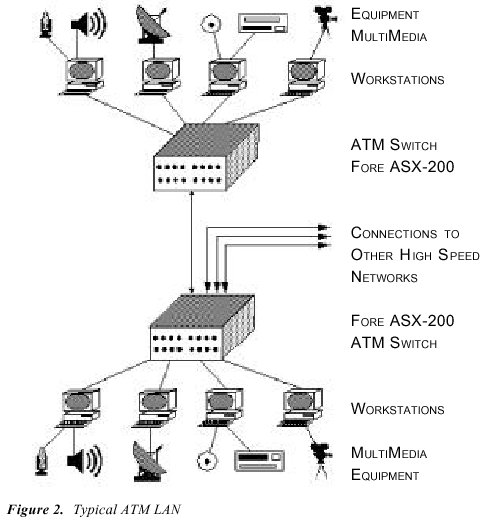
An ATM LAN switch is usually multiported, supporting between 10 and 20 ports. Most systems tend to be modular and customized by the user’s requirements and depth of his/her pockets. In addition, most ATM
LAN equipment vendors realize that there is considerable need to support legacy equipment and LANs, and there is usually provisions for incorporating legacy technology into ATM. For example, legacy technology can include existing ethernet, and it is actually one of the principal roles ATM will play in commercial and governmental deployment as it can be used efficiently and effectively to connect geographically isolated LANs as though they were on the same local LAN. In addition, there needs to be some mechanism to get connected to the outside network (edge equipment). This edge equipment is also available from a number of vendors. It is typically more expensive than the local ATM switch because it is likely to be owned by the network service provider or teleco. The equipment needs to meet much tighter specifications with respect to the “ilities” (maintainability, reliability, serviceability, etc.). Physically, the nodes on the local ATM LAN are connected by a pair of fibres (in/out). These fibres are usually of the multimode variety (fat core) that are limited to several hundred metres as opposed to the network side that is typically monomode (thin core) and can support transmission over much greater distances (kms).
The cost of these systems varies depending on specific configurations. It is probably safe to say that workstation cost will remain constant for a state of the art machine. The cost of ATM NICs and switches will rapidly come down as standards shake out and large scale VLSI components become commodity parts. A cost that will go up will be that of commercial application software. We hope there will continue to be a large university community of generous application developers and students.
For many applications, the broadband technology will be transparent to the application or user. That is, if the current protocol is IP, the sending ATM NIC hardware and/or driver software will fragment the IP packet, and the receiving NIC will reassemble the IP packet. This packet will have ATM routing information setup at the time a connection is made. This is not the most effective means for utilizing the available bandwidth as opposed to using ATM directly, but it allows for porting of a large number of existing applications. The trade-off here is rapid porting of existing applications at the expense of inefficient use of the available bandwidth. The next section gives a brief overview of an ATM-based desktop video conference that utilizes many of the technologies discussed above, including a number of more traditional “Internet” applications.
On December 18, 1995, an ATM desktop video conference took place between researchers from the University of Manitoba in Winnipeg and researchers at CRC Ottawa. During the conference, Professor Blight presented a lecture on FASTNet. The lecture was followed by presentations from Ottawa, including an overview of a NATO wireless network and a presentation by Dr. Simons (CRC) on a collaborative research project involving Professor Bridges from the Department of Electrical and Computer Engineering at Manitoba. Figure 3 illustrates the video conference session. In many learning situations, effective communication is significantly increased when only one or two students participate at a workstation in a comfortable environment. This environment contrasts with the more formal lectures where it can be difficult for a more timid student to participate.
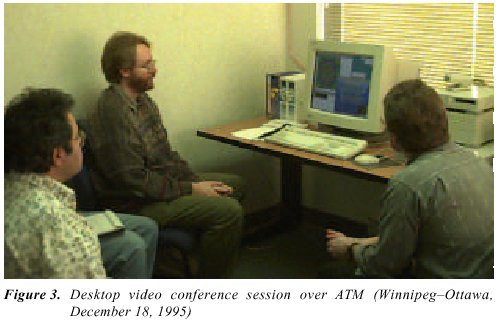
The presentations were workstation-based on one end (Manitoba) and conference room-based in Ottawa. During the presentation, audio/video and white board tools were used. Professor Bridges’s collaboration with Dr. Simons involved the remote use of highly specialized computer equipment (CAM-8), which was only available in Ottawa. This presentation represented a preliminary trial using remote access to a piece of equipment for experimentation. Figure 4 illustrates a screen capture of the presentation and actual data generated from the CAM-8 computer in Ottawa.
Although this demonstration was somewhat preliminary in its final configuration, we will likely be able to evolve broadband LANs on campus that will connect a number of workstations equipped with multimedia kits to support distance education. Specialized video conference rooms are being developed that we will be able to use for the formal lectures. Associated edge equipment and negotiating connectivity and bandwidth off campus presents a completely new set of problems, some of which are unknown at this time. The main point, however, is that collaboration is mandatory. For distance education to be effective, resources are required that span the hierarchy of technology from video conferencing at a dedicated facility to multimedia technology at the desktop. However, much of the infrastructure of a distance education course can be developed without using the technology employed for the video conference room.

Several test projects on distance education methodologies are planned or started.
The first test project began in January, 1996. Through the co-operation of the Faculty of Engineering, the Faculty of Agricultural and Food Sciences, the University of Manitoba Communication Services Group, TRLabs, and the University of Saskatchewan, two engineering courses, one originating at the University of Manitoba and the other at the University of Saskatchewan, were conducted. Both of them employed a combination of formal televised lectures, electronic laboratories, and the Hallway Effect.
The collaborative agricultural engineering courses were organized by Ron Britton, a professor in biosystems engineering. The project utilized the CANARIE National Test Network, MRNet (Manitoba Research ATM Network), and resources from Communications Systems at both universities. An audio/video connection was established twice a week over the NTN. The data exchange was JPEG, transported over ATM. Britton estimated that he required approximately five hours of preparation per one hour of class time to adapt the course content to teaching by electronic image transmission. Computer graphic images and teaching notes were displayed simultaneously on video screens at Winnipeg and Saskatoon. The course evaluated the bandwidth requirements ranging from 18 Mbps to 12 Mbps as the course progressed. An obvious evolution of the course lectures is to use newer technology, such as MPEG, as these standards evolve. One of the chief reasons for moving to MPEG is that the network bandwidth requirements will be reduced. The CANARIE Project pilot was not “more educational TV” but a more complex use of multimedia digital technology creating studio quality picture and CD quality sound in a teaching environment. Concurrent with the course, there was a project by Karin Sundstrom to develop the web-based support for the asynchronous aspects of the course. The project addressed the use of the Internet as a tool to support distance education.
The objective of the project was to create the Hall Effect. Using a PC, readily available communication software, and an Internet connection, the student was provided with access to the professor, course notes, and other resources using the Internet as the medium.
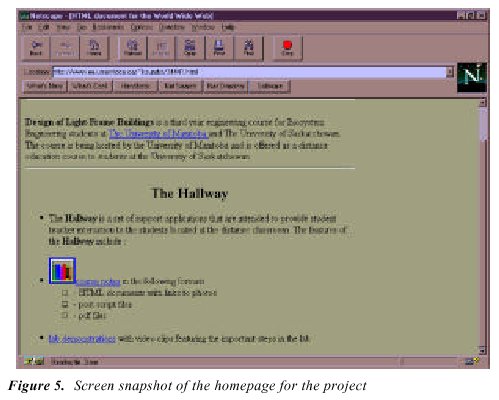
One of the main concerns with traditional distance education is lack of teacher-student interaction. Using Internet telephony applications, such as VocalTec Internet Phone and Microsoft NetMeeting, the student is able to have real-time, telephone-like conversations with the professor for the cost of the Internet connection only. In addition to telephony, Internet Phone and NetMeeting also provide video and shared workspace services. As shown in Figure 6, using NetMeeting, a student is able to see the professor in real-time and communicate in writing using the shared workspace feature. Internet Phone and NetMeeting support the H.323 protocol. Choosing H.323 compliant applications to create the Hall Effect allows students and teachers using different applications to communicate.
In addition, lack of access to laboratory facilities was addressed within the project by making video clips of the more important laboratory features available on the Internet.
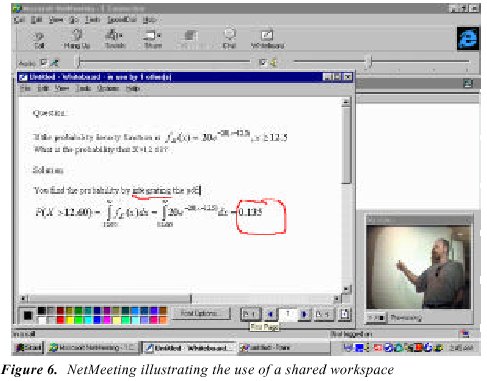
The second test project involves a suite of courses developed by the microelectronics and software systems group. In the past, we have developed a number of workshop tutorials and are in the process of converting them to a distance education format. These types of laboratories are well suited to high bandwidth networks because assistance from a remote expert (e.g., TA) is often required.
This project has evolved to include an overview of tools and methods suitable for supporting a remote expert, such as a teaching assistant. Although the objective is to employ remote expertise for students utilizing difficult to use design software for illustrative purposes, a similar effect can be achieved using a shared workspace. We have completed relatively extensive overviews and performance evaluations of a wide variety of these types of tools. It was not our intent to reinvent existing tools but rather to integrate them into a system tailored to our particular environment.
Another project currently under construction is the development of a web-based speech therapy course. The course is being developed for a Windows-based PC, and it will take advantage of multimedia support that is provided by popular web browsers (such as Netscape and Internet Explorer). The course will include a database of words and phrases enhanced by video demonstrations, interactive tutorials, and real-time access to the instructor using Internet telephone tools.
One additional project we would like to note is a collection of curricula-related applications using executable scripts and Java demonstrations. This project addresses the types of Internet courseware support one should expect to become part of a distance education course. For example, Abba Tregobov created a Java demonstration for an Engineering Algorithms course. This type of course works particularly well for animation supplemental to electronic course notes. The Java application is a scheduling problem using a greedy method.
The second illustration utilized a cgi script to illustrate the remote execution of a Genetic Algorithm.

Primary objectives of the test projects were
Samples of courseware have already been developed for several courses in the Department of Electrical and Computer Engineering here and elsewhere.
It is extremely difficult to state conclusions on topics as vast and as rapidly evolving as distance education and the Internet. Our impressions, however, are becoming slightly more solidified. Some of these include:
R. D. McLeod, M. G. Britton, A. Tregobov, and K. Sundstrom
Faculty of Engineering
University of Manitoba
Winnipeg, Manitoba R3T 5V6
E-mail contact: mcleod@ee.umanitoba.ca
Bates, T. (1996, February 14). Setting up and managing technology-based distance education course production [audio conference].
Bjerke, A. R. (1995, November). Video lecture wins national Telly award [Online]. Available Internet: <http://www.uwex.edu/disted/telly.html>. Definition web page [Online]. (1995, July). Available Internet: <http://www.uwex.edu/disted/definition.html>.
Dutta-Roy, A. (1998, July). Virtual meetings with desktop conferencing. IEEE Spectrum, 97-56.
Halfhill, T. R. (1996, March). Inside the Web PC. Byte, 21(3), 44-56. Lachance Wolcott, L., Napper, V. S., & Lindsay, R. E. (1994). Audio tools for distance education. In B. Willis (Ed.), Distance education strategies and tools (pp. 135-164). Englewood Cliffs, NJ: Educational Technology Publications.
Muller, N. J. (1996, February). Dial 1-800-internet. Byte, 21(2), 83-88.
Muller, N. J. (1996, March). Multimedia over the network. Byte, 21(3), 73-80.
Muth, K. (1995, September). A means to quality: Teachers discover distance education improves their teaching and learning [Online]. Available Internet: <http://www.uwex.edu/disted/means.html>.
Peters, O. (1993). Understanding distance education. In K. Harry, M. John, & D. Keegan (Eds.), New perspectives (pp. 10-18). London: Routledge.
Sandler, M. (1996, March). Definitions. the Net, 1(10), 60.
Waters, C. (1996, February). Real-time multi-party video conferencing: A basic guide to CuSeeMe. the Net, 1(9), 69-70.
Robert D. McLeod received his B.Sc., M.Sc., and Ph.D. degrees from the Department of Electrical and Computer Engineering at the University of Manitoba in 1981, 1983, and 1985. He is currently a professor in ECE at Manitoba and an affiliate professor at TRLabs in Winnipeg. Current research interests are in Internet application development, network-based computing, and applications ranging from microelectronics to software systems.
M.G. (Ron) Britton, P.Eng., received his B.E. from the University of Saskatchewan, M.Sc. from the University of Manitoba and Ph.D. from Texas A&M. He is a professor in the Department of Biosystems Engineering at the University of Manitoba, a 3M Fellow, and recipient of the CCPE Medal for Distinction in Engineering Education. Current te aching interests relate to the application of Team Learning techniques in engineering, computer-based enhancement of text materials, and creative design. Beginning in October 1998, he will serve a one year term as President of the Association of Professional Engineers and Geoscientists of Manitoba.
Abba Tregobov is currently completing a Masters of Science degree in Computer Engineering. He is also employed by the faculty of Continuing Education as a Web Developer/Programmer. The focus at Con. Ed. is the development of internet-based course delivery systems. His Masters thesis is entitled “Course Delivery and Management over the Internet.” He obtained a B.Sc. in Computer Engineering in May of 1996. He also has a diploma in Electronic Engineering Technology from Red River Community College. He has recently started a company called “Borderless Technologies” to provide frameworks for Internet-based courseware.
Karin Sundstrom graduated from the University of Manitoba in 1996 with a B. Sc. in Computer Engineering. She is currently completing her M.Sc. degree in Computer Engineering at the University of Manitoba. Continuing with her undergraduate work in Internet applications, her Master’s work has focused on Internet Telephony applications.
ISSN: 0830-0445